
What do the 7 Chakra Symbols Mean? Pictures, Shapes, Colours & Symbolism Explained
There is an intricate energy circuit that serves the human body, channelling life force energy throughout our being. This energy circuit is known as the Chakra System, composed of seven primary chakras situated along the spine, from its base to the crown of the head. While invisible and intangible, these chakras profoundly influence the spiritual, emotional, psychological, and physical dimensions of our existence.
The chakras function as the body’s energy hubs or centers. They are spinning wheels of energy that nourish our mind, body, and spirit with life force energy, also known as Ki, Prana, or Chi. This energy flows from the body to the rest of the universe via the aura, maintaining a dynamic exchange between our internal and external environments. They act as focal points for the reception and transmission of energy.
The term “Chakra” originates from the Sanskrit word for “wheel” or “disk.” Although many believe that the human body has 109 chakras in total, seven primary energy centers are of paramount importance. These are the main chakras most commonly referenced in spiritual and healing practices.
Each of these seven chakras is connected through a network of subtle energy pathways known as nadis, through which life force energy flows freely. Imagine these pathways as roads and the chakras as intersections where these roads converge. The life force energy, or Prana, can be likened to cars traveling through these intersections. Just as a well-functioning traffic system ensures smooth flow and connectivity, a balanced chakra system ensures the free and harmonious flow of energy throughout the body.
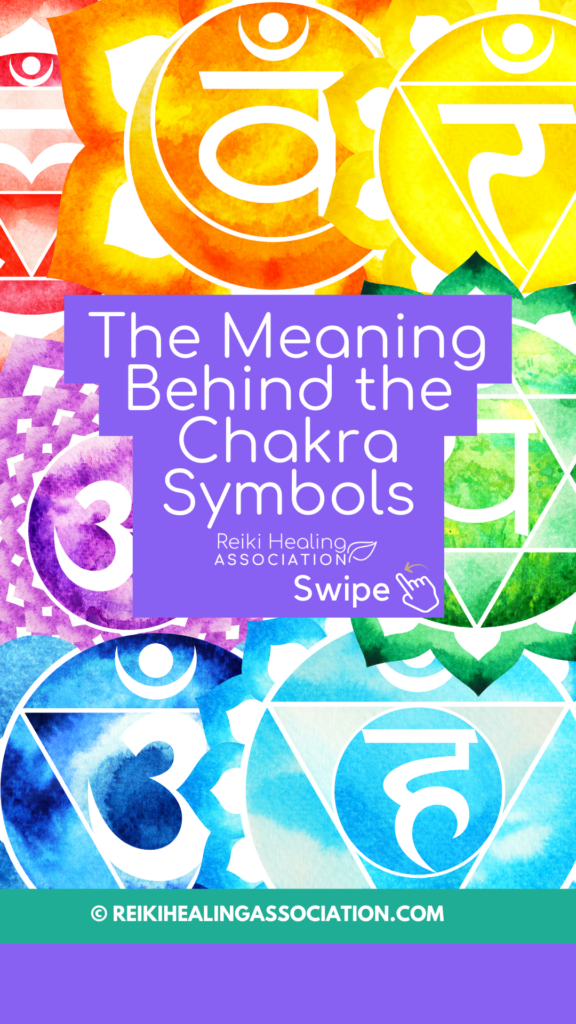
The 7 Chakras in the Human Energy System
Here is a brief overview of the seven primary chakras in the body:
- Root Chakra (Muladhara): Located at the base of the spine, it represents grounding and survival.
- Sacral Chakra (Svadhisthana): Located below the navel, it is associated with creativity and sexuality.
- Solar Plexus Chakra (Manipura): Located in the upper abdomen, it governs personal power and self-esteem.
- Heart Chakra (Anahata): Located at the center of the chest, it is linked to love and compassion.
- Throat Chakra (Vishuddha): Located at the throat, it relates to communication and expression.
- Third Eye Chakra (Ajna): Located between the eyebrows, it is associated with intuition and insight.
- Crown Chakra (Sahasrara): Located at the top of the head, it represents spiritual connection and enlightenment.
When these chakras are balanced and aligned, the life force energy flows effortlessly, promoting overall well-being and harmony. However, blockages or imbalances in any chakra can disrupt this flow, leading to physical, emotional, or spiritual challenges.
Understanding and working with the chakra system can help us maintain this vital balance, enhancing our ability to live a vibrant and fulfilling life. By tuning into the energy of our chakras, we can cultivate greater awareness, healing, and alignment with the universe.
Why are the Chakras different Colours?
The concept of chakras and their corresponding colors is deeply rooted in various spiritual traditions and holistic healing practices. Each of the seven main chakras is associated with a specific colour, which reflects its unique energy frequency and qualities.
Colors play a significant role in chakra healing and balancing practices. Each color vibrates at a specific frequency that resonates with the corresponding chakra, enhancing its function and promoting overall harmony. Here’s how color therapy can be integrated into chakra healing:
- Visualization: Practitioners often use visualization techniques, imagining the colors associated with each chakra to help balance and energize them.
- Crystals and Gemstones: Different colored crystals and gemstones are used in chakra healing to align and balance the chakras.
- Color Therapy: Incorporating colored lights, fabrics, or artwork in the healing environment can also influence the energy of the chakras.
Understanding the colours associated with the chakras provides a valuable tool for healing and self-awareness.
The 7 Chakra Symbols Explained
The chakra symbols are more than just visual representations; they embody the essence of each energy centre and its role in our overall well-being. Let’s explore each chakra now!
Root Chakra Symbol Meaning (Muladhara)
The Root Chakra, known as Muladhara, is the foundation of our energy system, much like the roots of the lotus anchored in the mud. The Root Chakra is associated with the sense of security, survival, and our basic needs such as food, shelter, and safety. It governs our connection to the Earth and is the foundation of our physical and energetic structure. The Root Chakra symbol is represented by a red lotus with four petals, with a square in the middle and an upside-down triangle inside.
- Four Petals: These petals represent the four aspects of human consciousness: mind, intellect, consciousness, and ego. They are also linked to the four fundamental elements: Earth, Water, Air, and Fire, which signify stability and structure.
- Square: The square in the symbol stands for stability, grounding, and a strong foundation. It is the base upon which all other energies build.
- Upside-Down Triangle: This triangle represents the spirit’s connection with the material world, symbolizing the grounding of spiritual energy into the physical plane.
- Red Colour: The bold and strong red colour symbolizes the red dawn of a new awakened consciousness. It reflects energy, strength, passion, and the primal life force.
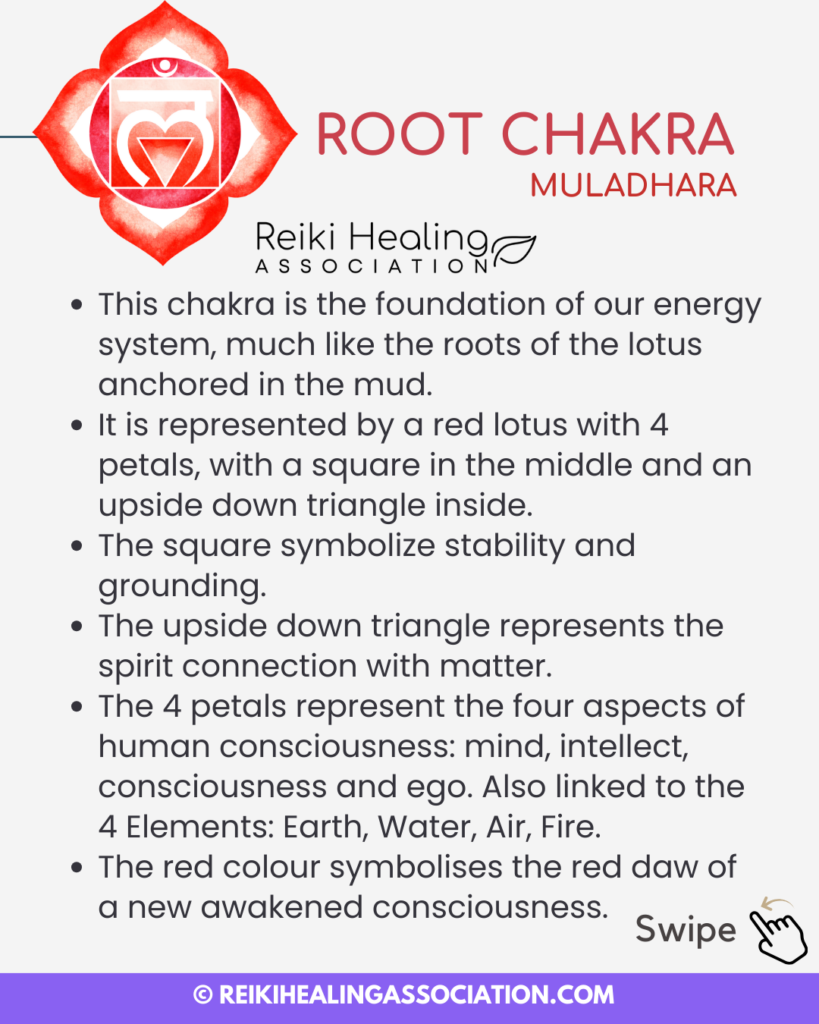
Sacral Chakra Symbol Meaning (Svadhisthana)
The Sacral Chakra, known as Svadhisthana, embodies creativity, sensuality, and emotional expression. It is associated with the flow of life and encourages flexibility and adaptability in the face of challenges. The Sacral Chakra is represented by an orange lotus with six petals. Inside the lotus is a crescent moon, symbolizing the element of water.
- Six Petals: These represent the six negative qualities that must be overcome to fully open this chakra: anger, jealousy, cruelty, hatred, pride, and desire.
- Crescent Moon: Symbolizes the link to the element of water, representing emotions, creativity, and the flow of life.
- Orange Colour: Reflects warmth, enthusiasm, and creativity, as well as the energy of joy and pleasure.

Solar Plexus Chakra Symbol Meaning (Manipura)
The Solar Plexus Chakra, known as Manipura, is the center of personal power and confidence. The Solar Plexus Chakra is represented by a yellow lotus with ten petals, featuring a downward-pointing triangle within a circle.
- Ten Petals: Represent the ten Pranas, or vital energy winds.
- Downward-Pointing Triangle: Symbolizes the fire element and transformative power.
- Yellow Colour: Reflects the energy of the sun, embodying power, strength, and vitality.
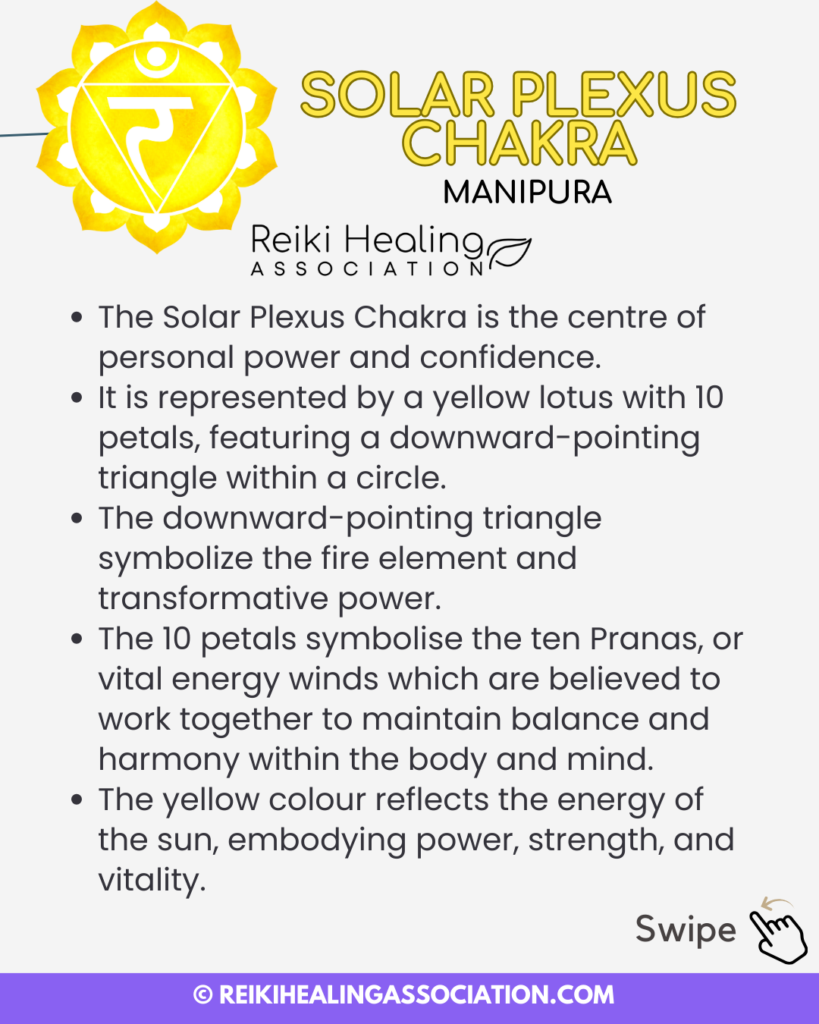
Heart Chakra Symbol Meaning (Anahata)
The Heart Chakra, known as Anahata, is the source of love and compassion. The Heart Chakra is represented by a green lotus with twelve petals, featuring a six-pointed star.
- Twelve Petals: Represent the twelve virtues essential for enlightenment: peace, bliss, love, harmony, understanding, empathy, clarity, purity, unity, compassion, kindness, and forgiveness.
- Six-Pointed Star: Symbolizes the union of male and female energy, balance, and harmony. It is made of two triangles, one pointing upwards and one pointing downwards – to symbolise how this chakra is the intersection between the lower and higher chakras.
- Green Colour: Reflects healing, growth, and love.
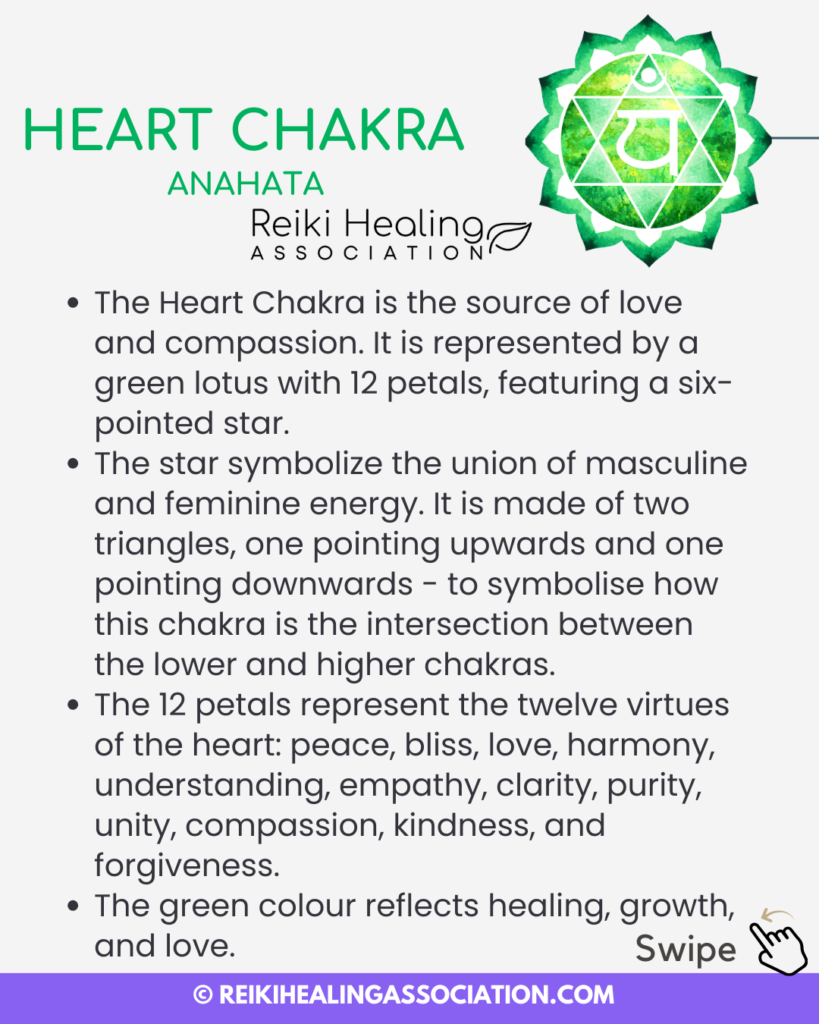
Throat Chakra Symbol Meaning (Vishuddha)
The Throat Chakra, known as Vishuddha, governs communication and self-expression. It is the first of the higher chakras. The Throat Chakra is represented by a blue lotus with sixteen petals, featuring a circle containing a downward-pointing triangle and a white circle.
- Sixteen Petals: Represent the sixteen vowels in Sanskrit, symbolizing purity and clarity of expression. It is a nod to the power of words, speech, and creative expression.
- Downward-Pointing Triangle: Represents the energy flowing from the lower chakras to the higher chakras. It represents the manifestation of speech and the unfolding of one’s spiritual potential.
- Blue Colour: The sky blue colour symbolises openness, truth, purity and authenticity.
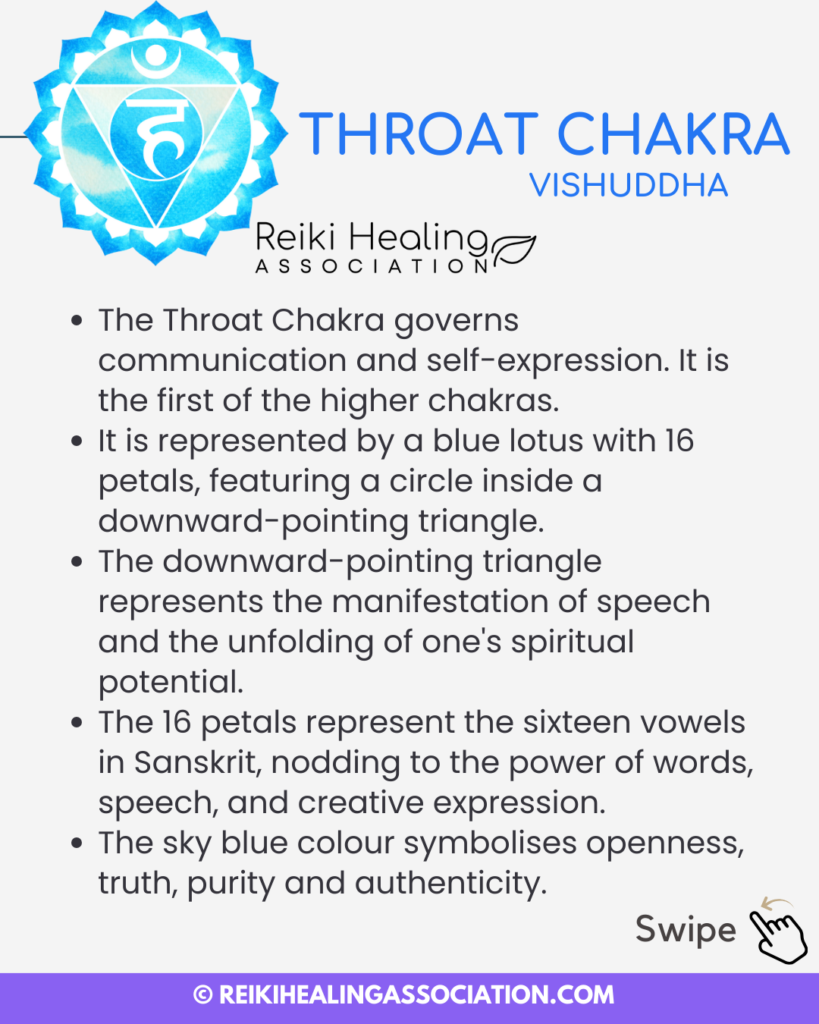
Third Eye Chakra Symbol Meaning(Ajna):
The Third Eye Chakra, known as Ajna, is the center of intuition and insight. The Third Eye Chakra is represented by an indigo lotus with two petals, featuring a downward-pointing triangle and an om symbol.
- Two Petals: Represent the duality of mind and the two hemispheres of the brain.
- Downward-Pointing Triangle: Symbolizes the wisdom that flows from intuition and higher consciousness.
- Indigo Colour: Reflects intuition, perception, and psychic abilities.
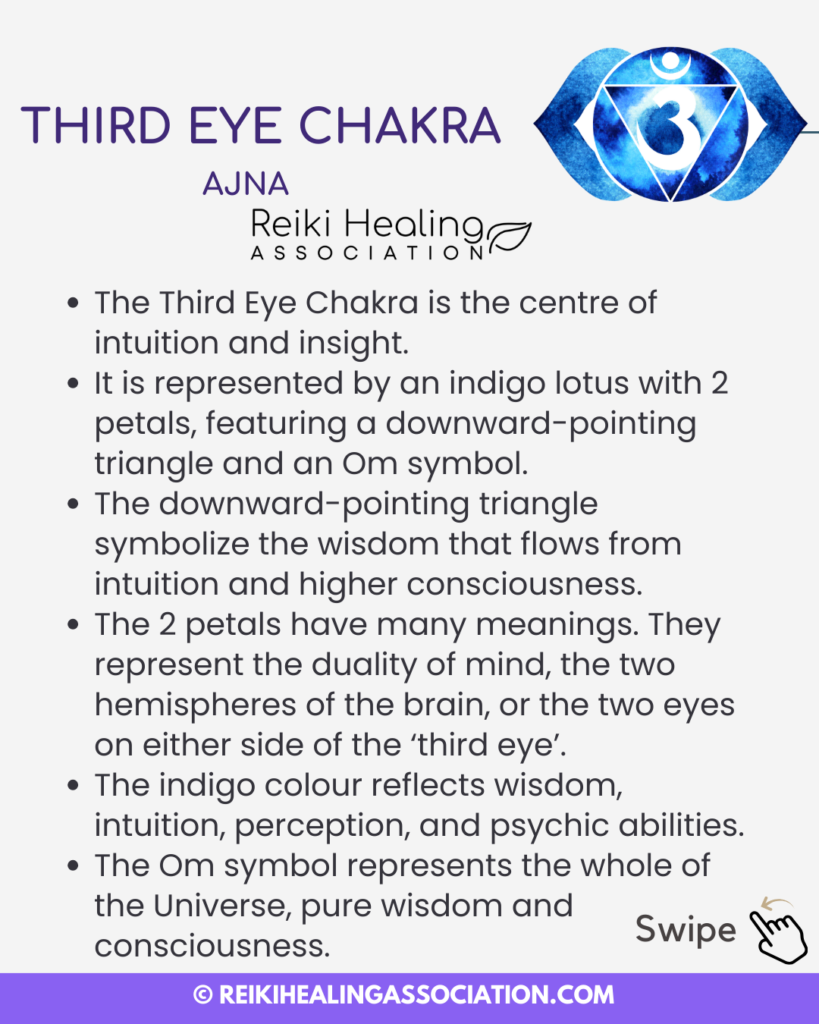
Crown Chakra Symbol Meaning (Sahasrara)
The Crown Chakra, known as Sahasrara, is the source of spiritual connection and enlightenment. The Crown Chakra is represented by a violet lotus with one thousand petals, featuring a circle.
- One Thousand Petals: Symbolize the infinite nature of the chakra, representing spiritual enlightenment and connection to the divine.
- Circle: Represents the unity and wholeness of the chakra’s energy.
- Violet Colour: Reflects spirituality, enlightenment, and the connection to higher consciousness.
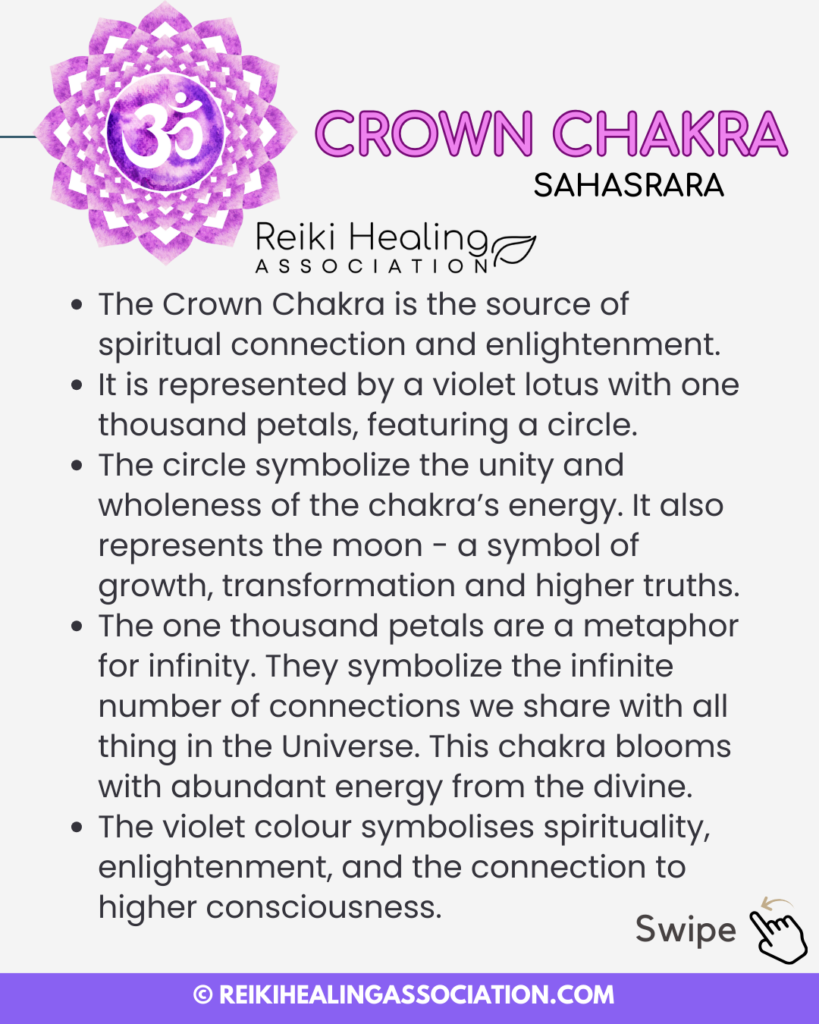
The Importance of Understanding Chakra Symbols
Having a comprehensive understanding of the chakra symbols and their meanings is beneficial for several reasons. This knowledge can not only enhance your practice but also deepens the healing experience for your clients. Here are some key benefits:
Improved Visualization and Meditation Practices
The Chakra symbols serve as powerful tools for visualization and meditation. When you can visualize the specific symbol and its corresponding energy centre, it helps you focus your intention and energy more precisely. This can lead to more profound healing experiences and a greater sense of connection to the universal life force.
Personalized Healing Spaces
Incorporating chakra symbols into your healing space can create an atmosphere that resonates with the energy centres you’re working with. Whether through artwork, crystals, or décor, these symbols can enhance the overall energy of your practice space, making it more conducive to healing and relaxation.
Effective Client Communication
Clients often benefit from understanding the concepts and symbols related to their healing journey. Being able to explain the chakra system, including the symbols and their meanings, helps demystify the process and empowers clients to engage more actively in their own healing. It fosters trust and a deeper client-practitioner relationship.
Conclusion
The lotus petal imagery in the chakra system represents the blossoming and awakening of each energy center as one progresses along the spiritual path. Just as the lotus emerges from the murky depths to bloom into a beautiful flower, the opening of each chakra leads to greater awareness, harmony, and spiritual evolution.
By understanding the significance of each chakra and visualizing its corresponding lotus, Reiki practitioners can help guide the flow of energy more effectively, facilitating deep healing and transformation.
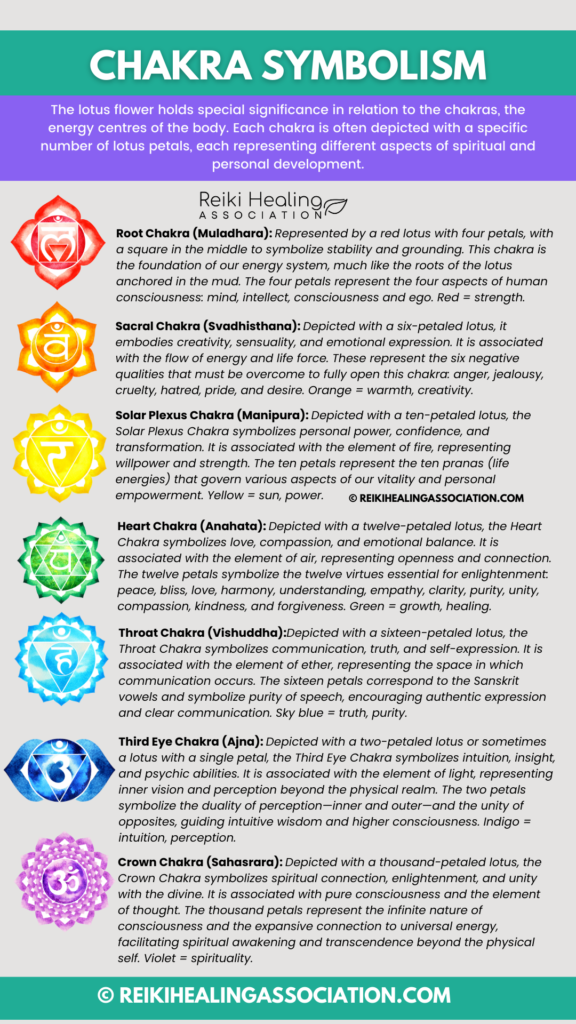
Like this article? Share your thoughts in the comment box below!
And for more Reiki resources, be sure to connect with the Reiki Healing Association on Instagram, where we post daily Reiki inspiration and advice for healing and growth as a Reiki Practitioner or Reiki-enthusiast! And don’t forget to follow us on Pinterest, where we are pinning positive affirmations and empowering quotes every single day.
Have you read the latest issue of Universal Life Magazine yet? As Members of the RHA you get Exclusive Access to the Magazine, and to access your copy all you need to do is log in to your Member’s Area. You can get a copy of the magazine if you subscribe to our newsletter too!
More Articles For You:
- The Beautiful Cho-Ku-Rei: Power in the Palm of Your Hand
- Reiki Vision Board: Releasing the Magic of Vision Boards with Reiki
- Self-Care for Reiki Practitioners
- Just for today I will be Grateful – How to Live Each Day with Gratitude
- Setting Up Your Week For Powerful Reiki Sessions
- What to Expect during a Reiki Session: Our Members Share the most common experiences


